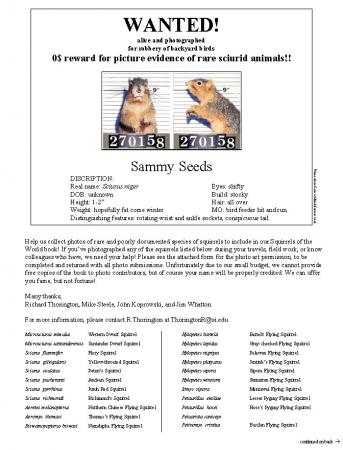All hail the squirrel since January 21 marks National Squirrel Appreciation Day, celebrated since 2001. Did you know the squirrel family includes groundhogs, prairie dogs, and chipmunks, and that there are more than 270 species of squirrels?

One person who studied squirrels, along with other mammals, was Dr. Richard W. “Thor” Thorington (1937-2017), curator emeritus at the National Museum of Natural History (NMNH). According to Smithsonian Magazine, Thorington initially studied primates in the forests of South America, but was diagnosed with Charcot-Marie-Tooth syndrome in 1976. Over time, he became unable to continue to travel and research in tropical climates, so he turned his focus to squirrels.

His collection at the Archives is Accession 18-100, National Museum of Natural History, Division of Mammals, Correspondence, 1934-1939, 1956-2017, which primarily documents his curatorial activities in the Division of Mammals at NMNH in regard to field work, research, publications, professional societies, lecturing, committees, and collections management. It also includes his time as chairman of the Department of Vertebrate Zoology and as director of the Smithsonian Primate Biology Program.

Thorington worked with many collaborators, both at the Smithsonian and externally, during his long career, and this is reflected in this collection. His digital files include a variety of presentations he gave about squirrels and chipmunks, including one he did with research assistant Jennie R.B. Miller in 2009 that used 3D imagery to compare hand bones in tree, flying, and terrestrial squirrels. There also are images that include everyday snapshots of squirrels doing what squirrels do, as well as X-rays and specimens. There is research data from the 1980s to the 2000s on topics including squirrel skull comparisons and squirrel teeth analysis. There even is a lighthearted file of a “wanted poster” seeking images of rare squirrels for a book he co-authored titled Squirrels of the World (2012).
Another book Thorington co-authored, with Katie Ferrell, was Squirrels: The Animal Answer Guide (2006). Some of the questions and answers posed include: Can squirrels swim? Yes; How small are South American Pygmy Squirrels? 1.2-1.6 ounces; and What is the largest squirrel? Marmots.
The oldest known fossil squirrel Hesperopetes thoringtoni, found in Wyoming, was named after Thorington in 2007.
Related Collections
- Tom (Mac) McIntyre Catalogs Squirrel Specimens, 1971, by Harry B. Neufeld, Smithsonian Institution Archives, Acc. 11-009, Image no. 71-510.
- Ground Squirrels, Collections, Smithsonian
Related Resources
- "How Ground Squirrels Keep Cool in the Summer," Smithsonian Channel
- Thorington, Caroline M., Ellen M. Thorington, and Katherine K. Thorington, "Obituary: Richard Wainwright Thorington, Jr. (1907-2017)." Journal of Mammalogy 99, no. 3 (June 2018): 741-749.
Produced by the Smithsonian Institution Archives. For copyright questions, please see the Terms of Use.

Leave a Comment